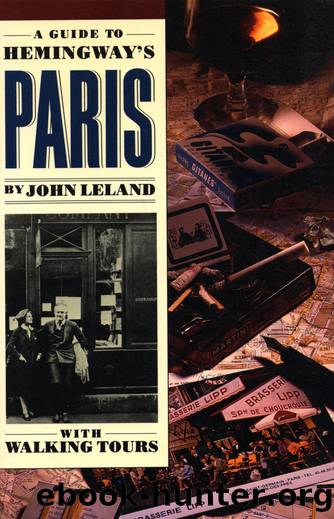A Guide to Hemingway's Paris by John Leland

Author:John Leland
Language: eng
Format: epub
Publisher: Algonquin Books
Published: 1989-01-01T00:00:00+00:00
Pablo Picassoâs apartment.
[5th; Monge]
91. Place de la Contrescarpe
What book-nourished Americans expect of the Left Bank, the Place de la Contrescarpe is a seedy, tree-shaded square lined with cafés, a boulangerie, boucherie, restaurants, a smattering of bums, and an épicerie.
Little has changed since Hemingway lived around the corner and a drunk Jake Barnes stumbled across the square sixty years ago. The S bus no longer stops here, and Au Nègre Joyeux is closed, but its sign remains. The Café des Amateurs, now La Chope, still has âthe long zinc barâ and is still crowded with âold men and women.â Carved in stone over the boucherie and restaurant chinois is the legend, âMaison de la Pomme de Pin MCC,â pretending to a drinking tradition as old as Rabelais.
Here Hemingway witnessed a Bastille Day party. Seated on wine casks, an impromptu band of an accordion, bagpipe, two drums, and a cornet led a crowd of âshop girls, butchers, bakers, laborers, tram conductors and laundresses, and bookmakersâ in a four-night revel, he told Star readers [Dateline, p. 183].
The colorful Rue Mouffetard starts here. Mouffetardâs daily market, its stalls crowding onto the alleyâs cobblestones, is the same that Henry Miller raved over. The odors of fish, roasting chicken, bread, and stale beer mingle with the cries of fruit vendors; street signs for the tabac, boucheries, cobblers, and bakers crowd the view, and people from every continent crowd the steeply sloping alley.
[5th; Luxembourg]
92. Place Edmond Rostand
Jake Barnes breakfasted on brioche and coffee in a Muirhead-recommended café where the Free Time Hamburger stands today. Florists and law students still trudge by in the morning, and working stiffs still catch the bus for the Right Bank out front, but styrofoam cups and âle hamburgerâ reign here and across the street at McDonaldâs. The only remnant of this part of Hemingwayâs Paris is still called the Luxembourg Bar, but has crossed the street and lost its allure and appears in only a few tourist guides.
Hemingwayâs favorite S bus is defunct, its route split up. But buses remain a great way to see Paris. What cost Hemingway four cents will cost you four francs today.
[5th; St. Michel]
93. Place St. Michel
The busy crossroads of the Left Bank, todayâs Place St. Michel is hardly the place to write a short story. Yet Hemingway says in A Moveable Feast that he frequented a quiet café here, drinking café au lait and rum St. James as he wrote âThe Three Day Blow.â And who knows, perhaps the storyâs subterranean tension owes as much to the rums and an anonymous French âbeauty ⦠whoever you areâ who chanced to sit opposite Hemingway as it does to the criticsâ preferred notions of a youthful love affair recollected in tranquility.
âEmpty and both sad and happy as though I had made love,â Hemingway feasts sensually after writing the story on âa dozen portugaises and a half-carafe of the dry white wineâ [AMF, pp. 5â6]. The French are famous for their huitres (oysters)âthe large, green, coppery marennes and fat, coppery belons, which Street says are âvery expensive, costing in good restaurants from $1.
Download
This site does not store any files on its server. We only index and link to content provided by other sites. Please contact the content providers to delete copyright contents if any and email us, we'll remove relevant links or contents immediately.
Spell It Out by David Crystal(35852)
Underground: A Human History of the Worlds Beneath Our Feet by Will Hunt(11841)
A Year in the Merde by Stephen Clarke(5080)
Venice by Jan Morris(2436)
Claridge's: The Cookbook by Nail Martyn & Erickson Meredith(2259)
My Paris Kitchen: Recipes and Stories by Lebovitz David(2135)
A TIME OF GIFTS by Patrick Leigh Fermor(2103)
The Plantagenets by Dan Jones(1935)
Welcome to the Goddamn Ice Cube by Blair Braverman(1888)
Bang Poland: How To Make Love With Polish Girls In Poland by Roosh V(1862)
Top 10 Prague (EYEWITNESS TOP 10 TRAVEL GUIDES) by DK(1852)
The Finnish Way by Katja Pantzar(1811)
The Isle of Mull by Terry Marsh(1806)
From Russia with Lunch by David Smiedt(1797)
A TIME TO KEEP SILENCE by Patrick Leigh Fermor(1774)
Rick Steves London 2018 by Rick Steves & Gene Openshaw(1752)
A Taste of Paris by David Downie(1747)
Merde in Europe by Stephen Clarke(1672)
Insight Guides Experience Tokyo by Insight Guides(1660)
